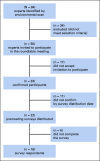Development of an Actionable Framework to Address Cancer Care Disparities in Medically Underserved Populations in the United States: Expert Roundtable Recommendations
- PMID: 33464925
- PMCID: PMC8202060
- DOI: 10.1200/OP.20.00630
Development of an Actionable Framework to Address Cancer Care Disparities in Medically Underserved Populations in the United States: Expert Roundtable Recommendations
Abstract
Purpose: Cancer disparities persist among medically underserved populations despite widespread efforts to address them. We describe the development of a framework for addressing cancer care disparities across the cancer care continuum (CCC), guided by the CCC domains established by the Institute of Medicine/National Academies of Sciences, Engineering, and Medicine (IOM/NAS).
Materials and methods: An environmental scan was conducted to identify strategies and associated experts who are providing or have successfully provided community- and/or patient-centric IOM/NAS-defined domain standards to our target populations. A multistakeholder expert roundtable working group was convened for framework development. A premeeting survey informed agenda development, documented expert practices for target populations, and identified priority areas for meeting focus.
Results: The environmental scan identified 84 unique experts across 8 stakeholder groups and 44 patient organizations; 50 were invited to the roundtable and 33 participated. They broadly represented disease sites, geography, and experience with target populations and all CCC domains. The premeeting survey (16 responses) identified coordination of care or patient navigation (66.7%), community engagement (60.0%), and healthcare system changes (53.3%) as priority focus areas. The experts identified access and treatment barriers or gaps within and between CCC domains, specified key notable practices to address these, and developed an actionable framework and recommendations for each priority focus area.
Conclusion: The framework and recommendations are intended to guide researchers, healthcare leaders, advocates, community- and patient-focused service organizations, and policy leaders to address and promote health equity in cancer care access and treatment outcomes.
Figures







Similar articles
-
The future of Cochrane Neonatal.Early Hum Dev. 2020 Nov;150:105191. doi: 10.1016/j.earlhumdev.2020.105191. Epub 2020 Sep 12. Early Hum Dev. 2020. PMID: 33036834
-
Addressing Cancer Disparities in SGM Populations: Recommendations for a National Action Plan to Increase SGM Health Equity Through Researcher and Provider Training and Education.J Cancer Educ. 2020 Feb;35(1):44-53. doi: 10.1007/s13187-018-1438-1. J Cancer Educ. 2020. PMID: 30377952 Free PMC article.
-
The intersection of disability and healthcare disparities: a conceptual framework.Disabil Rehabil. 2015;37(7):632-41. doi: 10.3109/09638288.2014.938176. Epub 2014 Jul 25. Disabil Rehabil. 2015. PMID: 25060038 Review.
-
Critical Care Network in the State of Qatar.Qatar Med J. 2019 Nov 7;2019(2):2. doi: 10.5339/qmj.2019.qccc.2. eCollection 2019. Qatar Med J. 2019. PMID: 31763205 Free PMC article.
-
Addressing disparities and challenges in underserved patient populations with metastatic breast cancer in Europe.Breast. 2021 Feb;55:79-90. doi: 10.1016/j.breast.2020.12.005. Epub 2020 Dec 13. Breast. 2021. PMID: 33360479 Free PMC article. Review.
Cited by
-
Interventions to improve access to cancer care in underserved populations in high income countries: a systematic review.Oncol Rev. 2024 Nov 5;18:1427441. doi: 10.3389/or.2024.1427441. eCollection 2024. Oncol Rev. 2024. PMID: 39564594 Free PMC article.
-
Assessments of social vulnerability on laryngeal cancer treatment & prognosis in the US.Br J Cancer. 2025 Aug;133(2):248-254. doi: 10.1038/s41416-025-03056-8. Epub 2025 May 15. Br J Cancer. 2025. PMID: 40374890 Free PMC article.
-
Mitigating Cancer Disparities Through an Innovative Navigation Program.N C Med J. 2023 Sep;85(1):25-29. doi: 10.18043/001c.91427. N C Med J. 2023. PMID: 39374360 Review.
-
Understanding mechanisms of racial disparities in breast cancer: an assessment of screening and regular care in the Carolina Breast Cancer Study.Cancer Causes Control. 2024 May;35(5):825-837. doi: 10.1007/s10552-023-01833-5. Epub 2024 Jan 13. Cancer Causes Control. 2024. PMID: 38217760 Free PMC article.
-
Disparities in relapsed or refractory multiple myeloma: recommendations from an interprofessional consensus panel.Blood Cancer J. 2024 Aug 27;14(1):149. doi: 10.1038/s41408-024-01129-0. Blood Cancer J. 2024. PMID: 39191731 Free PMC article. Review.
References
-
- Goss E Lopez AM Brown CL, et al. : American Society of Clinical Oncology policy statement: Disparities in cancer care. J Clin Oncol 27:2881-2885, 2009 - PubMed
-
- Polite BN Adams-Campbell LL Brawley OW, et al. : Charting the future of cancer health disparities research: A position statement from the American Association for Cancer Research, the American Cancer Society, the American Society of Clinical Oncology, and the National Cancer Institute. Cancer Res 77:4548-4555, 2017 - PubMed
Publication types
MeSH terms
LinkOut - more resources
Full Text Sources
Other Literature Sources
Medical

